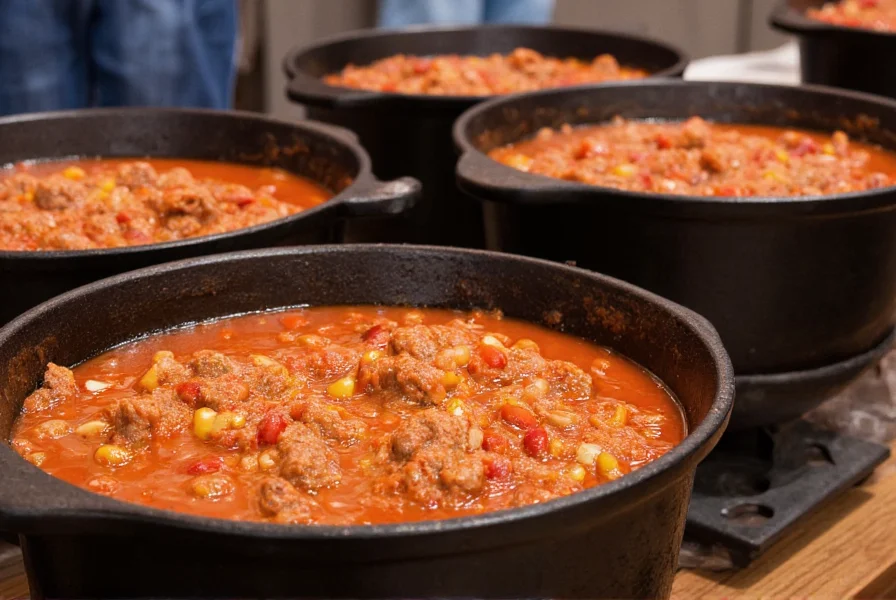No, authentic Texas chili does not contain beans. Traditional Texas-style chili, also known as “chili con carne” or “Texas red,” consists solely of meat (typically beef), chili peppers, spices, and sometimes a small amount of liquid for simmering—never beans. This culinary tradition dates back to the 1800s among cowboys and ranchers in Texas who valued the dish for its protein-rich, portable sustenance during cattle drives.
Understanding whether Texas chili includes beans requires examining both historical context and regional culinary identity. The absence of beans in authentic Texas chili isn't arbitrary—it represents a deliberate culinary choice rooted in practicality and tradition. Texas chili purists consider beans an adulteration that dilutes the rich, meat-forward flavor profile that defines this iconic dish.
The Historical Roots of Bean-Free Texas Chili
Texas chili originated in the mid-1800s among chili con carne cooks known as “chili queens” in San Antonio. These street vendors served a simple stew of meat, fat, and dried chili peppers—ingredients readily available to cattle drivers and settlers. Beans weren't part of the original recipe for practical reasons:
- Cattle drivers needed high-protein, non-perishable food that could cook over open fires
- Dried beef (later fresh beef) provided essential sustenance during long cattle drives
- Chili peppers served as both flavoring and food preservative
- Beans required additional cooking time and water—resources not always available
When the International Chili Society established competition guidelines, they codified this tradition: authentic Texas chili must contain only meat, chili peppers, spices, and liquid. Beans automatically disqualify a dish from official Texas chili competitions.

Texas Chili vs. Other Regional Variations
The bean controversy highlights fundamental differences between Texas-style chili and other regional interpretations:
| Chili Style | Key Ingredients | Bean Status |
|---|---|---|
| Texas Red | Beef, chili peppers, cumin, garlic | No beans allowed |
| Cincinnati Chili | Ground beef, Mediterranean spices, chocolate | Served over spaghetti with beans optional |
| New Mexico Chili | Green or red Hatch peppers, pork | Beans sometimes included |
| Midwest/"American" Chili | Ground beef, tomato, kidney beans | Beans standard |
While many commercial chili products and restaurant menus outside Texas routinely include beans, this represents a departure from the dish's Lone Star State origins. The traditional texas chili ingredients list remains remarkably simple: quality beef (often chuck or brisket), dried ancho or guajillo peppers, cumin, garlic, and occasionally oregano—all simmered slowly to develop deep, complex flavors.
Why the Bean Confusion Persists
Several factors contribute to the widespread misconception that chili must contain beans:
- Economic history: During the Great Depression, beans became a common addition to stretch meat portions
- Commercial products: Canned chili manufacturers added beans for texture and cost efficiency
- Regional adaptation: Northern states incorporated beans into their chili recipes
- Modern convenience: Many quick chili recipes use canned beans for faster preparation
When examining does genuine texas chili contain beans, the answer remains consistent across historical records and culinary authorities. The Texas State Historical Association explicitly states: “Authentic Texas chili con carne contains no beans, tomatoes, or other vegetables.” Similarly, the University of Texas at Austin’s Texas Chili Cook-Off rules prohibit beans in the traditional category.
The Great Chili Debate: Tradition vs. Innovation
While purists maintain strict adherence to bean-free recipes, contemporary interpretations vary. Some modern Texas chefs experiment with subtle additions while respecting the dish's essence. However, the texas chili bean controversy remains heated in culinary circles:
“Adding beans to Texas chili is like putting ketchup on a steak—it might be acceptable elsewhere, but it misses the point of what makes the original special.” — Lou Lambert, Texas barbecue historian
For those seeking authentic texas chili recipe without beans, the preparation method matters as much as the ingredients. Traditional recipes involve:
- Dry-roasting and rehydrating whole chili peppers
- Grinding spices fresh (especially cumin)
- Browning high-quality beef in animal fat (suet or bacon grease)
- Simmering for 4-6 hours to develop flavor without tomatoes or beans

Experiencing Authentic Texas Chili
To truly understand why texas chili has no beans, visit these Texas institutions known for traditional preparation:
- The Original Mexican Restaurant (San Antonio) – Serving since 1937
- Chili Parlor (Lockhart) – Open-air chili stand since 1952
- Terlingua International Chili Championship – Annual event upholding bean-free standards
When ordering at authentic Texas chili establishments, don't be surprised if the server asks how you want your chili served—straight up (in a bowl), two-way (with crackers), or three-way (with onions and cheese). Beans won't be an option because they violate the fundamental what defines texas style chili principle.
Conclusion: Respecting Culinary Heritage
The question does texas chili have beans ultimately speaks to broader issues of culinary authenticity and regional food traditions. While personal preferences vary, understanding the historical reasons behind Texas chili's bean-free composition enriches our appreciation of this iconic dish. Whether you're a chili enthusiast or casual diner, recognizing the distinction between authentic Texas chili and other variations helps preserve culinary heritage while making informed choices about what you eat.











 浙公网安备
33010002000092号
浙公网安备
33010002000092号 浙B2-20120091-4
浙B2-20120091-4